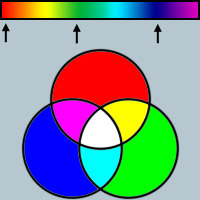
As you probably know... a given color of light can generally, be described by one number (e.g., the frequency of its wave length).
The color white, however, has no associated frequency; it is composed of equal amounts of all the (visible) frequencies of light. Black, of course, is the absence of light. And various shades of grey are generally composed of various intensities of white (as you lower the overall intensity of white, the grey gets darker and approaches black).
The question is: why is light (optically) additive? More specifically, why is it that when we add Red and Green together we get Yellow; Green and Blue together, we get Cyan; Red, Green, and Blue together, we get white?
(Please don't confuse this with the subtractive quality of pigments/paints, where as we add more colors, particularly more of the primary colors red, yellow, and blue, we approach black.)
Could we use three (or more) different colors and achieve the same result?
I am in general agreement with some of the earlier posters here, that the question is biology, not physics. The RGB system works well for TVs, monitors, etc. because of the eye's interpretation of colours, not for any underlying properties of wave mechanics. When we see something 'blue', for example, it is very unlikely that we are seeing a single-frequency blue light (unless we are looking at stimulated atomic emission or something like that).
Likewise for the question of additivity, when we combine R and G and get yellow, for example, we are not actually seeing any frequencies within the yellow band, we are just interpreting the addition of colours that way.
On a sidenote, humans have a heightened sensitivity to yellow due to its being the sun's peak frequency, so if we look at light that has any yellow in it, it is likely to appear fairly yellow. A good example of this is the star Betelgeuse (Orion's right shoulder). This star is a large red giant, so should appear very red, but it's spectrum extends somewhat into the yellow band, and the star consequently appears to the eye as yellow.
 As you probably know... a given color of light can generally, be described by one number (e.g., the frequency of its wave length).
As you probably know... a given color of light can generally, be described by one number (e.g., the frequency of its wave length).



